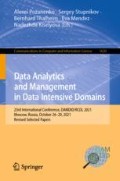Abstract
Crystal Structure Prediction (CSP) aims to discover solid crystalline materials by optimizing periodic arrangements of atoms, ions or molecules. CSP takes weeks of supercomputer time because of slow energy minimizations for millions of simulated crystals. The lattice energy is a key physical property, which hints at thermodynamic stability of a crystal but has no simple analytic expression. Past machine learning approaches to predict the lattice energy used slow crystal descriptors depending on manually chosen parameters. The new area of Periodic Geometry offers much faster isometry invariants that are also continuous under perturbations of atoms. Our experiments on simulated crystals confirm that a small distance between the new invariants guarantees a small difference of energies. We compare several kernel methods for invariant-based predictions of energy and achieve the mean absolute error of less than 5 kJ/mole or 0.05 eV/atom on a dataset of 5679 crystals.
Access this chapter
Tax calculation will be finalised at checkout
Purchases are for personal use only
References
Anosova, O., Kurlin, V.: Introduction to periodic geometry and topology. arXiv:2103.02749 (2021)
Anosova, O., Kurlin, V.: An isometry classification of periodic point sets. In: Lindblad, J., Malmberg, F., Sladoje, N. (eds.) DGMM 2021. LNCS, vol. 12708, pp. 229–241. Springer, Cham (2021). https://doi.org/10.1007/978-3-030-76657-3_16
Behler, J.: Atom-centered symmetry functions for constructing high-dimensional neural network potentials. J. Chem. Phys. 134(7), 074106 (2011)
Chisholm, J., Motherwell, S.: COMPACK: a program for identifying crystal structure similarity using distances. J. Appl. Crystallogr. 38(1), 228–231 (2005)
Edelsbrunner, H., Heiss, T., Kurlin, V., Smith, P., Wintraecken, M.: The density fingerprint of a periodic point set. In: Proceedings of SoCG (2021)
Egorova, O., Hafizi, R., Woods, D.C., Day, G.M.: Multifidelity statistical machine learning for molecular crystal structure prediction. J. Phys. Chem. A 124(39), 8065–8078 (2020)
Goodfellow, I., Bengio, Y., Courville, A.: Deep Learning, vol. 1. MIT Press, Cambridge (2016)
Gross, E., Dreizler, R.: Density Functional Theory, vol. 337. Springer, Heidelberg (2013)
KI Williams, C.: Gaussian Processes for Machine Learning. Taylor & Francis (2006)
Mosca, M., Kurlin, V.: Voronoi-based similarity distances between arbitrary crystal lattices. Cryst. Res. Technol. 55(5), 1900197 (2020)
Myles, A.J., Feudale, R.N., Liu, Y., Woody, N.A., Brown, S.D.: An introduction to decision tree modeling. J. Chemom. 18(6), 275–285 (2004)
Niketic, S.R., Rasmussen, K.: The Consistent Force Field: A Documentation, vol. 3. Springer, Heidelberg (2012)
Oganov, A.: Modern Methods of Crystal Structure Prediction. Wiley, Hoboken (2011)
O’Searcoid, M.: Metric Spaces. Springer, Heidelberg (2006). https://doi.org/10.1007/978-1-84628-627-8
Pedregosa, F., et al.: Scikit-learn: machine learning in python. J. Mach. Learn. Res. 12, 2825–2830 (2011)
Pulido, A., et al.: Functional materials discovery using energy-structure maps. Nature 543, 657–664 (2017)
Ropers, J.: Applying machine learning to geometric invariants of crystals (2021). https://github.com/JRopes/CrystalEnergyPrediction
Sacchi, P., Lusi, M., Cruz-Cabeza, A.J., Nauha, E., Bernstein, J.: Same or different-that is the question: identification of crystal forms from crystal structure data. CrystEngComm 22(43), 7170–7185 (2020)
Schütt, K., Glawe, H., Brockherde, F., Sanna, A., Müller, K.R., Gross, E.: How to represent crystal structures for machine learning: towards fast prediction of electronic properties. Phys. Rev. B 89(20), 205118 (2014)
Smith, J., Isayev, O., Roitberg, A.: An extensible neural network potential with DFT accuracy at force field computational cost. Chem. Sci. 8, 3192–3203 (2017)
Valle, M., Oganov, A.R.: Crystal fingerprint space-a novel paradigm for studying crystal-structure sets. Acta Crystallogr. A 66(5), 507–517 (2010)
Wales, D.J.: Exploring energy landscapes. Annu. Rev. Phys. Chem. 69, 401–425 (2018)
Ward, L., et al.: Including crystal structure attributes in machine learning models of formation energies via voronoi tessellations. Phys. Rev. B 96(2), 024104 (2017)
Widdowson, D., Kurlin, V.: Pointwise distance distributions of periodic sets. https://arxiv.org/abs/2108.04798
Widdowson, D., Mosca, M., Pulido, A., Kurlin, V., Cooper, A.: Average minimum distances of periodic point sets—foundational invariants for mapping all periodic crystals. MATCH Commun. Math. Comput. Chem. 87(3), 529–559 (2022)
Acknowledgements
Supported by £3.5M EPSRC grant ‘Application-driven Topological Data Analysis’.
Author information
Authors and Affiliations
Corresponding author
Editor information
Editors and Affiliations
Rights and permissions
Copyright information
© 2022 Springer Nature Switzerland AG
About this paper
Cite this paper
Ropers, J., Mosca, M.M., Anosova, O., Kurlin, V., Cooper, A.I. (2022). Fast Predictions of Lattice Energies by Continuous Isometry Invariants of Crystal Structures. In: Pozanenko, A., Stupnikov, S., Thalheim, B., Mendez, E., Kiselyova, N. (eds) Data Analytics and Management in Data Intensive Domains. DAMDID/RCDL 2021. Communications in Computer and Information Science, vol 1620. Springer, Cham. https://doi.org/10.1007/978-3-031-12285-9_11
Download citation
DOI: https://doi.org/10.1007/978-3-031-12285-9_11
Published:
Publisher Name: Springer, Cham
Print ISBN: 978-3-031-12284-2
Online ISBN: 978-3-031-12285-9
eBook Packages: Computer ScienceComputer Science (R0)

